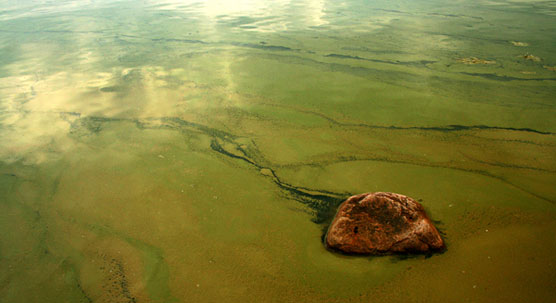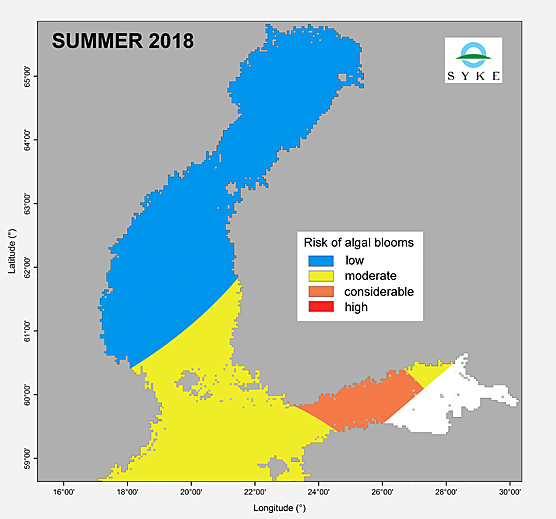Press release 2018-06-07 at 10:06

Blue-green algae bloom near shore. Photo: Niina Yliknuussi
The risk of widespread blue-green algae blooms in Finnish sea areas is less than during the last two years, because the algae have less nutrients available in comparison to previous years. However, significant algae blooms may form in the Gulf of Finland if the summer is warm. A warm May could cause blooms to occur earlier than normal this year.
According to the Finnish Environment Institute (SYKE), the risk of blue-green algae blooms in Finnish open sea areas this summer is high in western and central areas of the Gulf of Finland. In addition, the risk is moderate in the northern area of the main basin of the Baltic Sea, the Archipelago Sea and the southern areas of the Bothnian Sea. The risk is low in other parts of the Bothnian Sea and the Bay of Bothnia.

Risk of algal blooms 2018 © SYKE
"Weather conditions are a major factor affecting the blue-green algae situation; a warm summer allows more extensive algae blooms.to form. Last year, high nutrient levels in the sea water did not lead to significant blue-green algae blooms because the summer was cold", says leading researcher Harri Kuosa from Finnish Environment Institute.
The peak of blue-green algae blooms in Finnish marine areas occurs usually at the end of July and early August. The blooms may occur locally late into the autumn, but they are not generally as plentiful as during the summer. This year, a warm May might cause visible blooms earlier than normal.
Changes in the blue-green algae situation may be rapid
The movement of blooms that have formed in open sea areas to coastal areas depends on the prevailing wind and current conditions. Blue-green algae blooms are particularly likely to move to the archipelago and coastal areas when winds are blowing from the open sea. Strong winds mix the algae bloom with the surface water, which makes it more difficult to detect. When the conditions are calm, blue-green algae resurfaces quickly.
Regional current conditions and nutrition load sources at coastal and island areas may result in local blue-green algae blooms, especially during an extended period of calm and warm conditions. In addition, wind may accumulate algae in coastal waters and on shores.
Blue-green algae may form different types of toxins and agents that irritate the skin. Significant blue-green algae blooms should always be treated with caution.
The winter nutrient situation affects the risk forecast
The nutrient situation during the previous winter is the most significant factor affecting predictions about the risk of blue-green algae blooms. Due to refitting of the research vessel Aranda, much less nutrient information was available this year. Information was obtained with help from the Coast Guard, via Algaline monitoring by commercial ships, and measurements performed by the Swedish Meteorological and Hydrological Institute (SMHI) and Umeå University.
The risk of algae blooms was assessed using the Baltic Sea ecosystem model in co-operation between SYKE and the Finnish Meteorological Institute. The weather conditions over the coming summer cannot be forecasted with sufficient accuracy, so the blue-green algae bloom risk prediction is based on the wind, current and temperature conditions of five example years. The results produced by the model have been analysed by specialists, and experiences from the predictions and observations of previous years were also utilised.
The risk prediction of blue-green algae blooms best describes the conditions in open sea areas. The refitting of the Aranda means that many observations are unavailable for sea areas close to Finland, which significantly increases the uncertainty of the summer 2018 prediction.
Algae communication begins
SYKE will communicate weekly on the algae conditions of Finnish open sea areas from this week until the end of August.
Further information
Algae bloom risk analysis
Leading Researcher Harri Kuosa, Finnish Environment Institute SYKE,
firstname.lastname@ymparisto.fi, tel. +358 (0)295 251 106
Communications
Communications Specialist Eija Järvinen, Finnish Environment Institute SYKE,
firstname.lastname@ymparisto.fi, +358 (0)295 251 242
Full size risk map